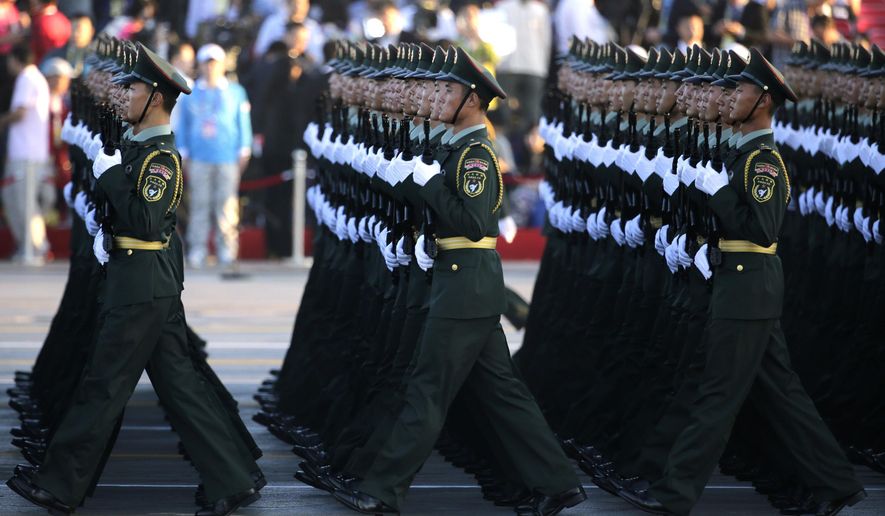“Comrade President, the troops are ready for your inspection!” shouted the People’s Liberation Army general in charge of the extravaganza.
“Let the inspection begin!” ordered Comrade President Xi Jinping, in a dapper Mao jacket, standing alone in an open-top inspection vehicle.
With that, the world’s largest military parade in recent memory got underway at 10 a.m. Thursday in the vast Tiananmen Square in central Beijing.
The ceremony was indeed grandiose, like all 15 previous parades since the founding of the Chinese communist state in 1949. On Thursday, over 12,000 Chinese troops participated in the event packaged as the Victory Parade commemorating the 70th anniversary of the defeat of Japan in World War II.
For three months, these PLA soldiers had practiced and sweated for the parade in Beijing’s notorious summer heat, drilled and choreographed by 56 top officers from all branches of the Chinese military. As Comrade President Xi passed each troop unit, the thousands of soldiers of identical height and physique stood in stoic inspection pose.
“Greetings, comrades!” the ebullient Comrade Xi shouted through a microphone
SEE ALSO: China woes send U.S. stock markets plummeting
“Greetings! Our Commander!” the troops shouted back in unison.
As the Xi-mobile turned around to inspect the troops from a different direction, the thousands of soldiers from each section of the inspection route shouted out the 16-character slogan formulated by Mr. Xi himself in March 2013 as an overall order to the PLA rank-and-file: “Absolutely follow the Party’s command. Be able to win a war. Develop an excellent moral character.”
All together, the gigantic parade had 67 formations of troops and military hardware, ranging from an all-female nursing corps at the Norman Bethune Military Medical Unit (named after a Canadian communist who served Mao Zedong’s troops and died in China during World War II) to the PLA’s intercontinental ballistic missiles such as DF-5As and DF31s, capable of reaching any target in the United States.
There were 11 marching phalanxes, 27 formations displaying weapons, 10 air flyover echelons and 17 foreign marching contingents from countries that — save for Russia — are not particularly known for their military prowess and global significance, including Afghanistan, Belarus, Cambodia, Cuba, Fiji, Laos, Mongolia, Tajikistan, Vanuatu and Venezuela.
In the prelude to the parade, the state-owned China Central TV put out a two-hour propaganda show repeatedly driving home three main themes: 1) Japan has been bad to China since the 1894-95 Sino-Japanese War and remains unrepentant for its past crimes; 2) the Communist Party was the leader and main fighting force against Japan during World War II, despite an overwhelming consensus among historians to the contrary; and 3) the Party has built a powerful military with which to lead the nation to realize Mr. Xi’s “China Dream.”
But not everything went smoothly, and the faux pas were quite unnerving at times.
SEE ALSO: U.S. considering sanctions against China, Russia for cyberattacks, officials say
About a half-hour before the parade started, the main CCTV English channel, its slavishly pro-party hosts and certainly the network’s propaganda officials were stunned by comments from a brave Chinese-looking commentator with a near-native British English accent, who suggested that Japan may have declined to send a representative to the parade because of its heavy emphasis on military might and weaponry, not from any attempt to whitewash the past.
“But they have a troubled record of how to look at history, especially the history of the Second World War!” the CCTV interviewer protested.
“We shouldn’t exaggerate that,” the off-message analyst responded. “The fact is that Japan is a liberal society, it’s a democratic society with different viewpoints of the history of Japan. And one thing worth remembering, for instance, is that some of the worst Japanese war crimes, for instance the Rape of Nanking, were first exposed in the postwar era by brave left-wing Japanese journalists. So we should remember the Japanese contribution to exposing their past as well.”
At which point the CCTV hosts hastily shifted to a description of the scene at the Forbidden City.
After such an unscripted heresy, the commentator was never seen or heard from again.
The flustered host, meanwhile, apparently lost control of his English, calling the Chinese capital city “the People’s Republic of Beijing” at one point and misidentifying the date of the publication of an important communist song by 100 years.
But the eeriest moment of the parade came when the first of the 27 weapons display formations, a large column of PLA’s Type 99 tanks, rolled into the Tiananmen Square. For millions of viewers inside and outside China, the image was jolting: It was 26 years ago, almost from the exact spot, that the PLA’s main battle tanks rolled into the square in the dark of the night to brutally crush a peaceful pro-democracy protest. It was just a short distance away that the next day a lone Chinese protester stood in front of a column of PLA tanks, giving the world an unforgettable image of the Chinese people’s bravery and defiance of repression.
Ironically, the last comment made by the CCTV host after Premier Li Keqiang declared the parade over was “Victory belongs to the Chinese!”, and the last 1940s-vintage song performed by the PLA chorus included the line: “Let all undemocratic systems perish!”
• Miles Yu’s column appears Fridays. He can be reached at mmilesyu@gmail.com and @Yu_miles.
• Miles Yu can be reached at yu123@washingtontimes.com.




Please read our comment policy before commenting.